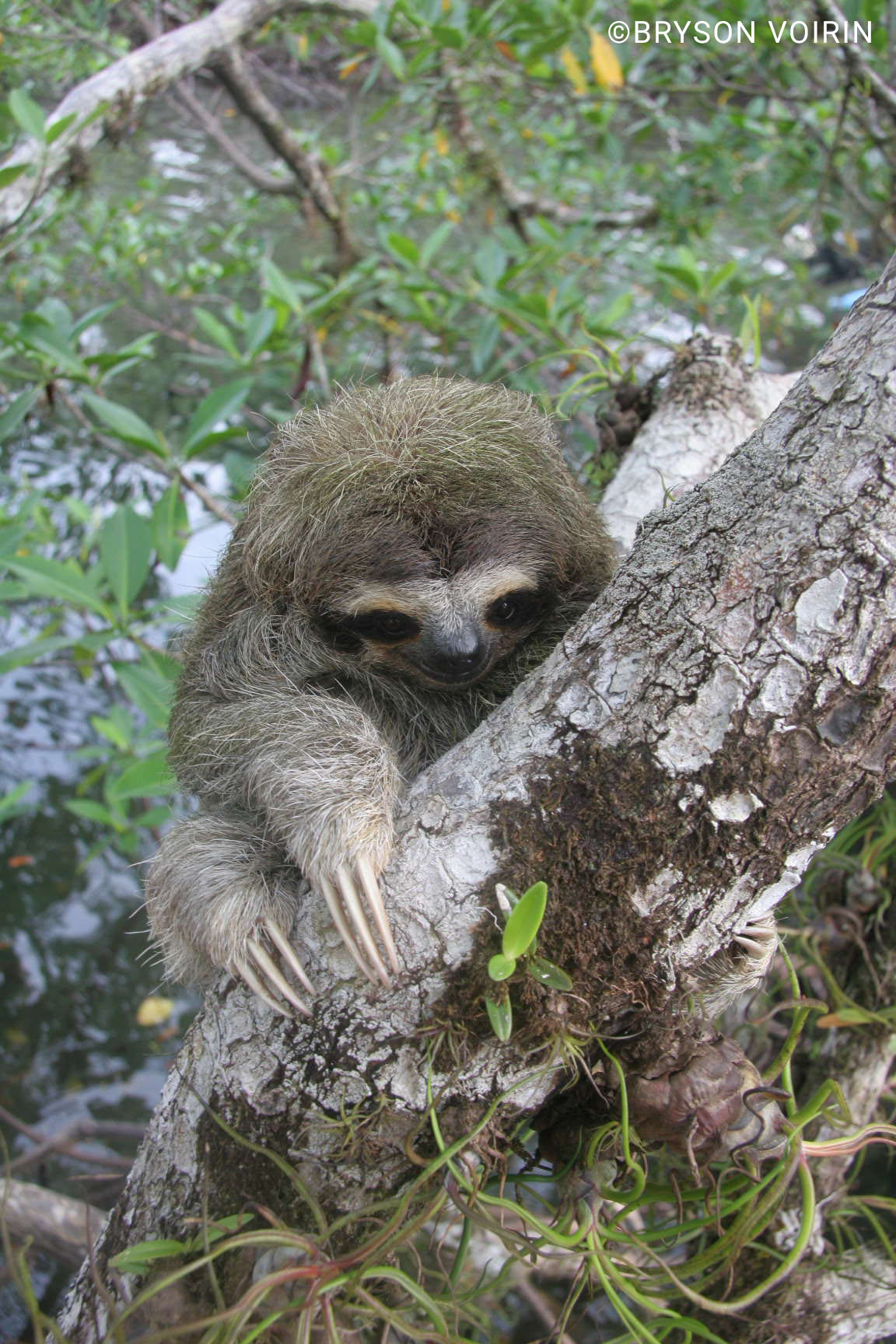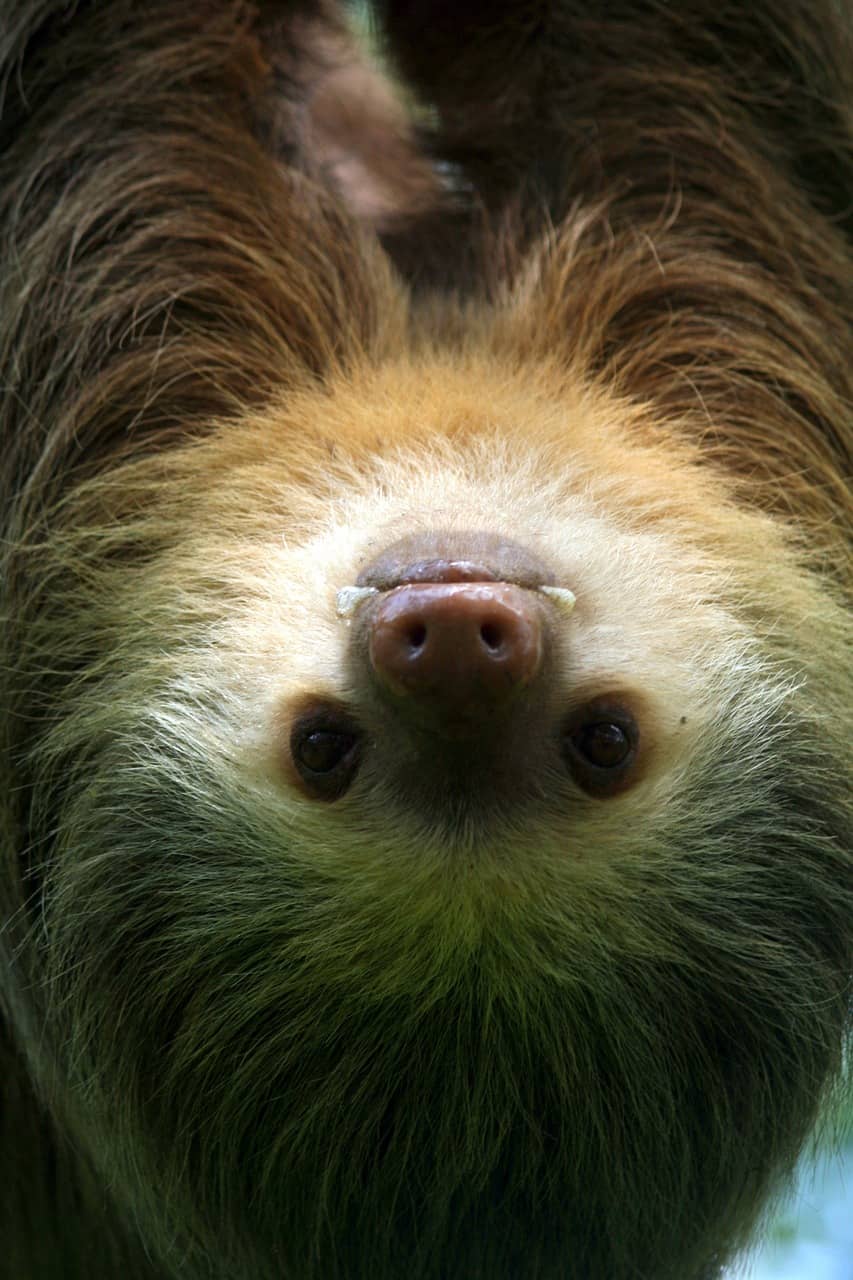Sloth Sloths live in the tropical forests of Central and South America. With their long arms and shaggy fur, they resemble monkeys, but they are actually related to armadillos and anteaters. Oct 19, 2018 Sloths seem to be everyone's 'spirit animal.' They get to eat, sleep, and hang out in trees all day, going about their business without a care in the world. Or at least that's how it looks. The pygmy sloth also has three fingers (like the three-toed sloth) but is much smaller. It is the smallest of the sloths, its body length is on average 40 cm, and its weight is no more than 2-3 kg. In all other respects, except for the size, it looks like its big three toed relative. The habitat of a sloth is the tropical rain forest. Sloths in their habitat make use of their long claws to hang on the branches so that they can eat the leaves that other animals are unable to reach. They also prefer sleeping while curled inform of a ball on a tropical tree.
- Picture Of A Sloths Habitat
- Describe A Sloths Habitat
- What Is A Sloths Habitat
- What Is A Sloths Habitat
- Climate Of A Sloths Habitat
Sloths are anatomically designed to fall out of trees. On average, a sloth will fall out of a tree once a week for its entire life. But don't worry, all sloths are anatomically designed to fall.
Appearance: Linné’s two-toed sloths are slow-moving, nocturnal creatures that spend most of their life upside down in the trees. They are the only mammals whose hair grows in the opposite direction. The hair parts in the middle of the belly and grows upward toward the back; the hair on the face points upwards too, which allows water to run off during rainstorms!
Habitat: They live in trees of tropical and cloud forests of Central and South America.
Family Life: Linné’s two-toed sloths live a life of solitary. Sloth youngsters stay with their mothers for six months to two years. Once they depart from their mother, they inherit a part of the home range left by the mother.
Threats: Threats include deforestation and habitat destruction.
Lifespan: Up to 20 years in the wild, 30 to 40 years in managed care
Slow Moving
Hidden in plain sight
The Phoenix Zoo is one of the largest non-profit zoos in the U.S., caring for over 3,000 animals, with nearly 400 species represented, including many threatened/endangered species.
Sloths are medium-sized mammals found in the canopy layer of the lowland tropical forest of south and central America: this includes the popular amazon rainforest also known as the “Amazonia”.
Conditions at the rainforest include: heavy amount of precipitation that persist year round, moderate daily temperatures that alternate between 70-90°F, a high relative humidity that overshadows this temperature to make the forest feel much warmer, a speedy rate of decomposition which leaves the bare grounds of the forests throughly siphoned of existing nutrients, and a very high diversity of living organism (plants, animals and planktons) which bestows the Amazonia the title for being the most biologically diverse ecosystem on the planet.
Special mention: Tropical rainforests are also a special dwelling place for unbelievably large sized mosquitoes. These creatures can inflict painful ‘bites’ that if given the natural abilities, they can chew. The amazon rainforest is definitely no home for anything less sturdy than a sloth.
The two extant families of sloths
Modern day sloths exist in two distinct families which include: the two fingered sloth: those possessing two claws on each forelimb, and three fingered sloths: those possessing three fingers on each forelimb.
In this article, we pick up from where most other publications left: that sloths live in the tropical rainforest forest of central and southern america, and give a more detailed breakdown of where each species of sloths occur within this large ecosystem.
Two Toed Sloths
Two toed sloths as mentioned above are members of the sloth group possessing two claws which serves as an extension of their forelimbs.
They are generally sturdier than their three toed counterparts and can be physically distinguished from them by their fast paced nature and relatively larger appearance.
Two toed sloths belong to the family: Megalonychidae and Genus: Choloepus.
They occur in two species namely:
- Linnaeus’s two toed sloth.
- Hoffmann’s two toed sloth.
An alternate but uncommon name for the two toed sloths is ‘unaus’. Below, we describe briefly and identify the habitat location of each species of two toed sloths.
1) Linnaues’s two-toed sloth (Choloepusdidactylus)
Description
Linnaeus’s two toed sloth are medium sized mammals that rival the side of a small dog. They have long shaggy coating, brown in color with a thick soft layer of dense underfur.
The hairs representing the outer part of the coating are grooved longitudinally with green algae residing in them. This gives the animals a greenish tinge that helps camouflage them from felid and bird of prey predators that hunt by sight.
Linnaeus’s two toed sloths have snouts that somewhat resemble those of pigs (an even makes them look like pigs) and are primarily differentiated from their closest brothers from the coloration on their necks. Adults can weigh up to 8 kg and live for up to 30 years or more in captivity. Their mean average lifespan under human care (or in captivity) is around 12 years.
Picture Of A Sloths Habitat
Location
In the canopy layer of the tropical and subtropical forest of Northern south america east of the andes and south to the central amazon basin. Temperatures in this habitat usually averages at 25.2 degrees Celsius.
Map
2) Hoffmann’s two-toed sloth (Choloepushoffmanni)
Description
Hoffmann’s two toed sloths have tan to light brown shade of fur with a much lighter coloring on the face. They weigh equally as much as the Linnaeus’s species and appear physically similar to them; they also have long snout that resemble those of pigs and also makes them look like them.
Location

Distributed between the mature secondary and deciduous rainforest of Central and Southern America from Nicaragua to Peru and western Brazil. The inhabit the canopy layers of these forests.

Map
Three Toed Sloth
Three toed sloths are members of the modern day group of sloth possessing three curved claws serving as an extension of their forelimbs. They are much smaller, less stronger and less sturdier than their cousins: the two toed sloths.
Three toed sloths have a marked coloration on their faces which confers them a perpetually smiling expression all the time.
They have forelimbs that are around 50 percent longer than their hind limbs and have stubby little tails that are more conspicuous than those of the two toed variety and are used for digging scatting holes.
Three toed sloths belong to the family: Bradypodidae and Genus: Bradypus.
They occur in four species namely:
- Brown throated three-toed sloth.
- Pale throated three toed sloth.
- Maned three toed sloth.
- Pygmy three toed sloth.
An alternate name for three toed sloths is ‘ai’ (in Latin America) because of the irritatingly high pitched scream they produce when agitated. Below, we describe briefly and identify the habitat location of each current member of the three toed sloth family.
1) Brown throated three-toed sloth (Bradypusvariegatus)
Description
They form the most common species of three toed sloths. Their sizes range between 2 kg to 4 kg and their lengths between 40 cm to 80 cm.
These species of sloths have rounded heads, blunt noses and inconspicious ears. The color of their fur is greyish-brown and it runs all over the body with a darker brown fur covering their throat area, forehead and sides of the face.
A very dark stripe of fur runs beneath their eye area. Their remaining facial hairs are often much paler. The hairs of three toed sloths are long and groovy with algae usually infesting during the humid atmosphere of the rainy season.
Location
Widespread between Central and Southern america. Areas include from Honduras to northern Argentina.
Map
2) Pale-throated three toed sloth (Bradypustridactylus)
Description
Pale throated sloths are very similar in appearance to the brown throated variety. The two species actually diverged into separate groups some 6 million years ago.
Pale throated sloths have pale yellow patches of hair around their throat areas. Their furs and color distribution are somewhat similar in appearance to those of brown throated sloths.
Their range mass is between 3 kg to 5 kg and their length span is usually between 50 cm to 80 cm. Species are sexually dimorphic like the brown and pygmy species with adult males having a large patch in the middle of their backs which lacks guard hairs. The patch reveals the naturally white under fur which sometimes may occasionally be stained bright yellow or orange.
Location
Found primarily in northern South America. Areas (or countries) include: Guyana, Suriname, French Guiana, eastern Venezuela and Brazil, north of the amazon river.
Map
3) Maned three toed sloth (Bradypustorquatus)
Description
The maned three toed sloths derives its name from the black mane hair that runs down its neck and over it’s shoulders.
Maned sloths have facial region with organs compacted at the middle. Their pelages are pale brown to grey in color. Maned sloths lack the large patch of hair located in the middle of the back as seen in the other three toed species.
They are therefore physically indistinguishable from their female counterparts. Their range mass is between 4 kg to to 5 kg and length span between 50 cm to 80 cm.
Location
Found primarily in Brazil: in the small atlantic forests on the south eastern Brazil.
Describe A Sloths Habitat
Map
4) Pygmy three-toed sloth (Bradypuspygmaeus)
Description
What Is A Sloths Habitat
Pygmy sloths are a critically endangered species of sloths that closely resembles the brown throated three toed sloth. They are also known as monk sloth or dwarf sloths.
They are significantly smaller than all the other members of the three toed family. In fact, one research found out that brown throated three toed sloths were on average, 40 percent heavier than the three toed pygmy species. Pygmy sloths have range masses that span between 2 kg to 3.5 kg and length span between 40 cm to 55 cm.
Location
What Is A Sloths Habitat
Found primarily in central America: Escudo de Veraguas; caribbean island off the northwestern coast of panama.
Map
Climate Of A Sloths Habitat
Sloths’ adaptations to their habitat
Below are some of the adaptations that sloths have made in order to survive the different challenges they face: from depredation risks to natural and unavoidable occurrences like flood and heightened fall, in their tropical habitat.

- Sloths have an arboreally adapted body mass that allows them to hold onto tree branches for hours on end without getting fatiqued, and also enables them to withstand fall from upto 10 feet.
- Sloths have body furs infested with myriad green algae in order confer them camouflage against raptors and ground predators.
- Sloths body can tolerate the toxic chemical contents derived from eating tropical leaves. This includes a long and exhaustive digestive process that properly breaks down the toxic chemicals and a slow rate of metabolism that carefully regulates their absorption.
- Sloths have teeth secondarily used for biting on their aggressors and sharp claws for clawing at them.
More interesting sloth articles:
Obsessed with sloths? Check out our sloth category to learn more about them:
Reference
Gardner. A. (2020, April 30). Phyllophaga, tree sloth. Retrieved from https://www.britannica.com/animal/sloth
Cite this Article ” (APA Format)
Bunu. M. (2020, June 15). Sloth Habitat: Where do sloths live? (with map). Retrieved from http://emborawild.com/sloth-habitat/